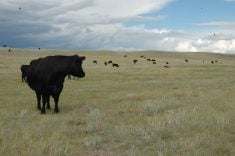SASKATOON — In an unprecedented move, milk quotas have been increased less than three weeks into the new dairy year.
The Canadian Dairy Commission boosted industrial milk quota by two percent Aug. 16 after discovering that butter stocks were well below expected levels.
The increase is retroactive to the beginning of the dairy year Aug. 1 and boosts the national market share quota (MSQ) to 43.7 million hectolitres.
“By reacting quickly to our revised assessment of demand, we hope to be able to increase milk production in the fall to improve the balance between anticipated milk supply and demand for the 1994-95 dairy year,” said Gilles Pregent, chair of the dairy commission.
Read Also

Soybean market still figuring out implications of China-U.S. pact
Soybean futures had a muted reaction to the U.S. trade deal with China as the market tries to figure out the nuances of the deal.
The increase is good news for farmers, said Neil van Ryssel, chair of the Manitoba Milk Producers’ Marketing Board.
Production up, costs static
“You can probably produce two percent more with the same fixed costs and facilities,” he said. That will be a welcome change from the last few years, when quota cuts created financial pressure for some producers.
In July, the Canadian milk supply management committee had settled on MSQ of 42.9 million hL for 1994-95, based in part on projected year-end butter stocks of 9.6 million kilograms.
But later calculations revealed the actual number was 8.7 million kg, and strong demand early in August drew stocks down to 7.9 million kg less than three weeks into the new year.
Dairy commission planner Nelson Coyle said the market for dairy products has turned around dramatically. As recently as three months ago, the industry was contemplating a reduction in a 2.5 percent MSQ increase that went into effect in November 1993.
Consumer demand has been boosted by increased tourism this summer and a reduction in cross-border shopping in the U.S.
Last Christmas, demand for butter jumped by 15 percent over the year before, forcing the dairy commission to authorize the import of 750,000 kg of butter. The agency didn’t want to be faced with a similar situation.
“What we’re doing is sending a signal to farmers we’ll need more milk this fall,” said Coyle. “We would not necessarily have had to import butter but it would have left things very tight. We did not want to be living hand-to-mouth at the end of the calendar year.”
Increasing production will also give retailers more flexibility in terms of pricing and offering specials on dairy products.
Coyle said the dairy commission is not concerned about having too much milk in the system. The worst-case scenario, if demand were to unexpectedly decline, would be a slight increase in butter stocks at the end of the dairy year.
Industrial milk is used to make products like cheese, ice cream and yogurt. About 59 percent of milk production goes to the industrial market, with the remaining 41 percent used to produce table milk and fresh cream.
The additional MSQ will be divided up among the provinces on the same basis as the current quota.














